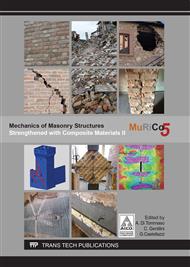p.111
p.119
p.128
p.134
p.142
p.150
p.158
p.166
p.174
Post-Cracking FRCM Strengthening of an Arch Composed by Hollow Clay Elements Embedded in Mortar: Experimental Investigations and Numerical Analyses
Abstract:
The use of hollow clay elements (fictile tubules, amphorae and caroselli) for erecting arches, vaults and domes was a building technique very popular in the Mediterranean area from the Roman Empire on. It was devised to ensure lightness and thermal insulation of structural elements. This paper presents experimental investigations and some preliminary numerical analyses regarding an arch consisting of caroselli embedded in mortar. A full-scale laboratory model was constructed and subject to vertical loads. After the development of hinges, the arch was repaired and strengthened with FRCM strips and further loads were applied to investigate the post-strengthening mechanical behavior. Also, numerical models of caroselli and mortar are created in Abaqus. Then, an elementary cell comprised of caroselli and mortar is created. The mechanical properties of the cell are evaluated by studying its behavior under uniaxial tensile and compressive loads. These properties set the basis for a possible homogenized material which can be used for numerical analyses of the arch.
Info:
Periodical:
Pages:
142-149
Citation:
Online since:
July 2017
Price:
Сopyright:
© 2017 Trans Tech Publications Ltd. All Rights Reserved
Share:
Citation:


